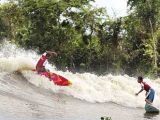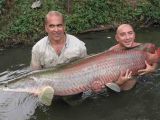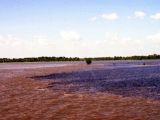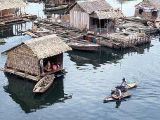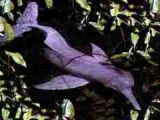It is the "father of all rivers". With 6,800 km (4,250 mi) in length, it overpasses the Nile (6,695 km or 4,184 mi). But the Amazon's debit is 60 times bigger than that of the former: 200,000 cubic meters/second (the largest in the world, delivering 20 % of the freshwater volume penetrating the oceans).
While the Nile does not have any affluent on its last 2,400 km (1,500 mi), the Amazon receives 1,100 along its course, some extremely powerful. The Amazon volume is that of Mississippi, Nile and Yangtze together, forming a freshwater layer into the Atlantic 200 km (125 mi) away from its 80 km (50 mo) wide mouth and carrying sediments 108 km (70 mi) into the ocean.
The name of the river comes from the expedition led in 1542 by the Spanish explorer Francesco de Orellana, the first one to travel along the river from Andes to Atlantic. Gaspar de Carvajal, a monk the in the expedition of Orellana described indigenous women fighting "as 10 men", handling extremely easily bows and arrows... Nobody is sure if the women were real or just born from the jungle fever, but the members of the expedition resembled them with the Amazons, the warrior women of the Greek mythology.
Amazon has a navigable network of 25,000 km (16,000 mi). Iquitos (Peru) is considered a port at the Atlantic, because of the Amazon! There is even a natural canal, turned navigable by humans, linking Amazon to Orinoco, the second largest river in South America.
The river originates in a Peruvian glacial lake in the Andes, at 5,250 m, near Cailloma, at just 160 km (100 mi) off the Pacific coast. This stretch is called Apurimac. In Brazil, it is called Solimoes before uniting with Rio Negro (near Manaus), when it changes its name to Amazon.
The color of the Amazon varies continuously, due to the color of the waters brought by its affluents. Rio Negro ("Black River") coming from the north disgorges water loaded with black forest soil; southern affluents bring crystalline water, filtered by sandy soils; western affluents have light brown waters, due to the Andean rocks; other affluents are green. Where the black Rio Negro flows into the muddy Amazon, the waters do not mix for 10 km (6 mi), due to the difference in composition, density and temperature.
During the flooding season, the Amazon widens to 50 km (31 mi): one bank cannot be seen from the other and its depth goes between 50 and 130 m. Some Amazon affluents are 6.4 km wide and 60 m deep. Rio Negro and Madeira (3,000 km), Amazon's largest affluents, have a larger debit than Congo (Africa), the second river in debit after Amazon.
The mouth experiences a phenomenon called pororoca: a wave 4.5 m (15 ft) tall going upward till 1,000 km (625 mi). The huge freshwater flow stops the tidal water, so that the sea level grows out of the river's mouth till it cannot be stopped and the huge wave goes against the river, changing its flowing sense, breaking the river's edges, pulling out trees and leaving a trail of destruction, all happening with an terrible noise. Pororoca occurs also because of the low pending, of 2 cm/km.
The Amazon benefits from summers in the two hemispheres and its levels vary largely, with the rainfalls; the oscillation can be up to 12 m (40 ft). The flooding forced people to build the houses on stilts or they are floating, over rafts tied close to the villages. During the flooding, the cattle must be relocated.
Once Amazon flawed into the Pacific Ocean, as part of a proto-Congo system when Africa and South America were a sole continent. When they split, the rise of the Andes forced the Amazon towards the Atlantic.
The Amazon basin covers 7.2 million square km, on 8 countries (Brazil 60 %, Bolivia, Columbia, Ecuador, Guyana, French Guyana, Suriname, Peru and Venezuela), forming the largest tropical forest and the largest water basin on Earth, on 8 % of the total ground area of the planet. 23 % of the freshwater on Earth is harbored by the Amazon basin and this forest, the size of western Europe, could generate about 50 % of the oxygen on Earth. 26 % of the Amazonian areas are considered protected areas (biological reserves, national forests, ecological stations).
There are about 300,000 Native Indians living in Amazonia, in 34 protected areas, while once their number was of 5 million. Today the foreign populations may be of about 10 million people, formed mainly by older or recent poor immigrants from other areas of Brazil. Caboclos represent a population made of a mix of Indians and White people established in the area 100 years ago. They live in huts over stilts placed along the rivers. They number about 2 million and their main occupations are nut harvesting, rubber collecting and fishing.
The basic diet of the Amazon people is made by cassava and fish, but there are also cultivated bananas, watermelon, corn, acai palms and buriti palms (local fruit trees).
The Amazon forest is the most diverse biome on Earth: it comprises about 30 % of the Earth plant and animal species. There are 4,000 tree species and 60,000 flowering plants, 1,800 bird species (more than in any forest), 300 mammal species and 2 million species of insects. Remarkable Amazonian fauna species there are: the plathirine monkeys, tapirs, sloths, anaconda snakes, vampire bats, giant otters, huge tarantulas, caymans and others.
There are over 3,000 species of fishes in the Amazon (half of the total freshwater fish species in the world), more than in any other river and than in the Atlantic Ocean! Famous Amazon fish are the terrible piranhas, just 30 cm (1 ft) long, living in groups that devour anything (the fish can crash with their teeth iron chains or 2.5 cm wood planks) and the electric eel, that can kill a man with electric discharges. There are three giants in the river: boto or the Amazon river dolphin (2.5 m long and 150 kg heavy); pirarucu (Arapaima gigas, the largest freshwater fish in the world, 3 m long and 200 kg heavy), appreciated in the local cuisine and Amazonian manatee, a vegetarian water mammal related to the elephants that can be 2.5 m longs and reach 350 kg in weight; an individual can deliver 100 liters of fat to the hunters.
During the rainy season, the Amazon grows in debit, 'swelling' the forests in the lower areas. During this time, tambaqui (Colonnonea macropomum), a fish with a fine olfaction, swims amongst the submerged trees, looking for nuts. The fruits are digested but the seeds are not, so that this fish contributes to the spreading of the trees. Cutting those trees menaces tambaqui and another about 200 fruit eating fish species. Many popular aquarium fishes come from Amazon, like angelfish or discus.
In the Amazon forest, there can be 300 species of trees over one hectar (as a comparison, in the most diverse US forest, there are no more than 50 tree species on the same surface). The rubber tree, Brazilian nut tree and some tropical fruit trees, more local (acai fruits (Euterpe oleracea, a palm), bacuri (Platonis insignis) and cupuacu or cupuarana (Theobroma grandiflorum), a close relative of the cacao tree (Theobroma cacao)) are considered famous trees originating in the Amazon forest. About 1,650 plant species from Amazon could serve as food in the future. Many valuable food plants have for the moment just local use, like lulo or naranjilla (Solanum quitoensis) (a tomato relative), babaco (Vasconcellea heilbornii) a papaya relative.
About 2,000 species of medicinal plants are utilized by the Indians of Amazon. 10 Amazon species are already employed on large scale by drug companies.
Cat's claw (Uncaria tomentosa) is a woody vine related to the coffee tree, employed locally in Amazonia (Peru, Bolivia and Ecuador), drunk as infusion. The plant has antiviral and immune system boosting qualities. Dragon blood (Croton lechleri), a tree related with the rubber tree, has a bark secreting a reddish latex. The latex induces rapid scaring formation on skin wounds and in small doses treats stomach ulcer. The drug Provir, based on Croton, is employed against chronic diarrhea induced by AIDS. Guayusa (Ilex guayusa), a relative of the mate herb and European holly is used by locals as depurative and stimulant. Alkaloids from Amazon vines are used as muscular relaxants before surgery.
An Amazon periwinkle has delivered a drug that helps 80 % of the leukemia diseased children to prolong their lives.
Local shamen use some plants in ceremonial or sacred rites (they are of course hallucinogen): ayahuasca (Banispteriopsis caapi) and various species of floripondio (Brugmansia species) from the potato family, closely related to jimsonweed (Datura).
Other extremely toxic vine plants deliver the venom employed for smearing arrow tips for hunting and fishing. The bark of curare (Strychnos toxifera) is grated and slowly cooked till releasing a dark deadly tar forms, the famous curare poison that paralyzes quickly the heart. The curare poison is used for making the surgery anesthetic called tubocurarine. In some regions of the Amazon, the curare poison is made of Curarea tecunarum.
The poison of barbasco (Lonchocarpus urucu, L. nicou), a type of wild bean related plants, is used for fishing. The rubbed plants are thrown to the rivers and in half an hour the fish are affected.
Other famous medicinal plants from the Amazon are maca (Lepidium maca), guarana (Paullinia cupana), saragosa (Aristolochia guentheri), quinine tree (Chinchona species) (which delivers for centuries the main drug against malaria), Amazon cinnamon (Ocotea quixos), ablu (Pouteria caimato), bocote (Cordia alliodora) and others. Digitalin from Amazon foxglove is used against cardiac insufficiency. Diosgenin obtained from Amazon yams is used for getting progesteron from contraceptive pills.
The Amazon is already heavily exploited for its resources. Over 20,000 km of roads and 900 km of railway have been built in the area. Brazil's largest iron reserves are found on the Amazon (18 billion tonnes). Iron of the basin Sierra Dos Carajas has been exploited for 30 years. Other resources are bauxite (4 billion tonnes), copper (1 billion tonnes), magnesium, nickel, gold, silver, potassium.
The hydroelectric potential of the Amazon basin surpasses 70,000 MW. The powerful hydrocentral Tucurui (4,000 MW) was built on the river Tocantins. In the area, bauxite has been exploited for a long time. 60 large dams are planned in the Amazon area.
The river is navigable for large cargo ships till Manaus (1,500 km (920 mi) from its mouth) and middle cargo ships can navigate till Iquitos, 3,700 km (2,300 mi) from its mouth. Manaus, once the capital of the rubber, has now 1.6 million habitants.
The industrial agriculture of soy is a big menace for the Amazon system. Today, the Amazonian ecosystem is in great danger due to the huge number of immigrants, lured by the promise of receiving free land. The deforestation rhythm is intense, at about 36,000 square km per year. 20 % of the Amazon forest has been already cut down, twice the surface of Germany. The changes on the ecosystem of the Amazon are regarded as impacting the global climate and they increase the carbon dioxide emissions.
About 40,000 fires occur annually in the Amazon area, put by the farmers, and the burning of the trees on the Amazon accounts for the 5 % of the carbon dioxide quantity dumped annually into the atmosphere. Normally, the wet canopy retains under it the humidity charged air, keeping the forest so wet that it cannot be fired. But the recent red of the roads made by loggers looking for mahony has led to the loss of the humid atmosphere in many areas in eastern Amazon area. Laying on the ground, branches and useless part of the treetop are burnt, turning the forest even more vulnerable. By cutting just 2 % of the forest, 56 % of the canopy is lost. The flames can burn uncut trees an a distance of 5 km (3 mi).
The forests of the Amazon concentrate the nutrients in the trees. When cut off, the fragile soil is gone and the soil proves uncultivable after one-two crops. For 1-2 years the terrain give a satisfactory harvest, as the ash of the burned trees and bushes serves as fertilizer. But artificial fertilizers are expensive and ineffective, as these soils cannot capture them. In fact, the original rock of the Amazon is nutrient poor and located extremely deep. The litter made of fallen leaves, twigs and fruits is essential in recycling nutrients. Annually, 8 tonnes of litter reach a hectare of Amazon forest. About 40 % of the litter is processed by termites, and their cultivated fungi release nitrogen, phosphorus and calcium. If a too large patch of the forest is removed, the rainfall will also decrease. The soil turns more compact, as rainfall falls directly on it. The burning sun also compacts the soil and desertification can install. The rainfall goes now directly to the rivers, not into the soil. The lose of nutrients in the deforested soil can be so severe, that the neighboring river can get eutrophicated, menacing the life in them.
Forest patches cannot ensure the survival of the species, as for examples trees pollinated by bats, usually dioic (male and female) can be encountered at distances too large to reproduce. Just the extinction of one plant can mean the end for 30 animal species. Many plants are affected even by the disappearance of one animal species if they depend on it for their dispersal. Thus isolation, and species over-exploitation (poaching) affect the ecosystem, even when the forest is not totally cut down. This shows the fragility of the Amazon ecosystem: any imbalance in an area brings a disequilibrium in all the other components of the system.
The problem is aggravated by the fact that some species are endemic on a limited forest surface. For example, out of the 1,025 plant species found on 1.7 square km patch of an Amazon area in Ecuador, 250 species were endemic to that area. Some monkey species are limited to just one small forest area.
When the soil can no longer be cultivated, the foreigners start to raise cattle or sell their lots, entering the protected areas or the Indian zones. A hectare of forest transformed into pasture produces $ 25 annually, thus a farmer, for gaining the minimum wage, must have 48 hectares of pasture and 16 cattle. Moreover, the pastures degrade in 6 years.
The penetration of the foreigners menaces Indians' traditions, hunting and fishing habits and their culture. Many tribes have been decimated in the confrontation with the foreigners and a lot of their vast knowledge about thousands of plants and animals was lost. Many of the foreigners had not even known anything about Amazon's soil, clime and suitable crops.
Specialists developed methods through which they transformed abandoned bauxite mines into a lush vegetation in just two years by implanting into the seeds of the trees of nitrogen fixing bacteria. This way the trees grow faster. But the second growth forest cannot compare with the virgin forests. A botanist compared an Amazon area reforested 100 centuries ago and found that from amongst 268 species blooming in a virgin forest, only 65 did it in the new forest. Thus, second growth forests are a lower quality imitation of the original.
Road makers, loggers, miners and other workers rule the Amazon forest like a carpet, producing huge environmental damages. The danger that the global warming comes with is that of turning many areas of the Amazon forest in grassy savannas, even without the human intervention.
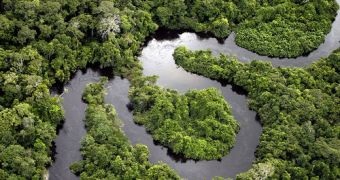
 14 DAY TRIAL //
14 DAY TRIAL // 
